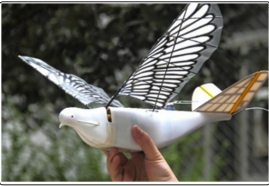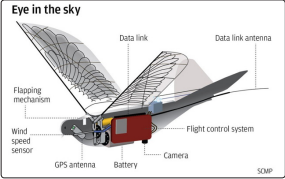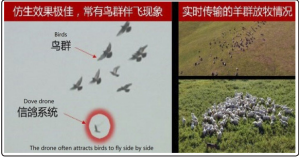Author(s): <p>Robert Skopec</p>
China takes surveillance to new heights with flock of robotic Doves, but do they come in peace? Hi-tech drones that look and move like real birds have already flown over restive Xinjiang region. Beijing Institute of Technology recruits 31 ‘patriotic’ youngsters for new AI weapons development programe. Expert in international science policy describes course as ‘extremely powerful and troubling.’ Also group of some of China’s smartest students have been recruited straight from high school to begin training as the world’s youngest AI weapons scientists. The 27 boys and four girls, all aged 18 and under, were selected for the four-year “experimental programme for intelligent weapons systems” at the Beijing Institute of Technology (BIT) from more than 5,000 candidates, the school said on its website. The BIT is one of the country’s top weapons research institutes, and the launch of the new programme is evidence of the weight it places on the development of AI technology for military use.
China brings Star Wars to life with “laser AK-47”

China is in competition with the United States and other nations in the race to develop deadly AI applicationss - from nuclear submarines with self-learning chips to microscopic robots that can crawl into human blood vessels.
“These kids are all exceptionally bright, but being bright is not enough,” said a BIT professor who was involved in the screening process but asked not to be named because of the sensitivity of the subject [1, 2].
“We are looking for other qualities such as creative thinking, willingness to fight, a persistence when facing challenges,” he said. “A passion for developing new weapons is a must … and they must also be patriots” [3, 4].
A total of 31 students have been chosen to take part in a four-year course on intelligent weapons systems at the Beijing Institute of Technology. Each student will be mentored by two senior weapons scientists, one from an academic background and the other from the defence industry, according to the programme”s brochure. After completing a short programme of course work in the first semester, the students will be asked to choose a speciality field, such as mechanical engineering, electronics or overall weapon design. They will then be assigned to a relevant defence laboratory where they will be able to develop their skills through hands-on experience [5, 6].
One of the students is Qi Yishen from east China”s Shandong province, who said he had had a keen interest in guns and weapons since he was a young boy and enjoyed reading books and magazines on the subject.
China tests stealth “invisibility cloaks” on regular fighter jets

As well as being offered an interview for the BIT programme he was in the running for a place at Tsinghua University, one of China”s top seats of learning, but both visits were scheduled for the same day [7, 8].
“When I arrived in Beijing, I loitered at the railway station for a long time. But then I went to BIT … I couldn”t resist the attraction,” he was quoted as saying on the institute”s website. He said his decision was also influenced by his father, who wanted him to work in the defence industry. BIT launched the programme at the headquarters of Norinco, one of China”s biggest defence contractors. “We are walking a new path, doing things that nobody has done before,” said student representative Cui Liyuan in an official statement. After completing the four-year course, the students are expected to continue on to a PhD programme and become the next leaders of China”s AI weapons programme, the institute said. Eleonore Pauwels, a fellow in emerging cybertechnologies at the Centre for Policy Research, United Nations University in New York, said she was concerned about the launch of the BIT course [9, 10].
“This is the first university programme in the world designed to aggressively and strategically encourage the next generation to think, design and deploy AI for military research and use. ”
While the US had similar programmes, such as those run by the Defence Advanced Research Projects Agency, they operated in relative secrecy and employed only the cream of established scientists, Pauwels said.
Will China”s new laser satellite become the “Death Star” for submarines? In contrast, the BIT programme seemed more focused on training the next generation of students in weaponising AI, she said. “This concept is both extremely powerful and troubling.”Students would conceive and design AI as an engine or an enabling force to weaponise self-learning, intelligent and automated systems, she said. That knowledge could also be used alongside other new and existing technologies such as biotechnologies, quantum computing, nanotechnology and robotics, which would have “drastic implications for security and military dominance”, Pauwels said. “Think of robot swarms capable of delivering harmful toxins in food or biotech supply chains,” she said. With the undergraduate programme, “you could envision students starting to think about how to harness the convergence of AI and genetics systems to design and deploy powerful combinations of weapons that can target, with surgical precision, specific populations”, she said. “[It] may also lead to new forms of warfare, from highly sophisticated automated cyberattacks to what you could call an “internet of Battle Things”, where an array of robots and sensors play a role in defence, offence and in collecting intelligence”. When asked to comment on the BIT programme, China”s foreign ministry said the country was actively engaged in the development and application of AI technology to serve its economic, social development, and scientific and technological progress [11-13].
At the same time, it said it was also very aware of the possible problems with a lethal autonomous weapon system, and promoted the exploration of preventative measures by the international community
China developing robotic subs to launch new era of sea powerIndeed, AI offers a new security arsenal for China, which has its sights firmly set on technological advancement as a way to achieve its goal to become a global leader [14, 15]. “The fact that China”s AI national strategy is built on a doctrine of civilmilitary fusion means that an AI prototype for military use could be co-opted and perverted for surveillance or harm in the civilian context,” Pauwels said. Stuart Russell, director of the Centre for Intelligent Systems at the University of California, Berkeley, described the BIT programme as “a very bad idea”. “Machines should never be allowed to decide to kill humans. Such weapons quickly become weapons of mass destruction. Moreover, they increase the likelihood of war,” he said. “I hope all these students will begin their course by watching the movie Slaughterbots.”
China”s robotic spy birds take surveillance to new heightsHe was referring to a seven-minute film screened at a United Nations arms control convention in Geneva last year, which depicts a disturbing future where swarms of low-cost drones can slaughter humans like cattle with the help of artificial intelligence technology like facial recognition.
Watch: “Slaughterbots”, a warning against AI weaponry screened at the UNThe Chinese government submitted a position paper to UN on the use of AI weapons in April. “As products of emerging high technologies, development and use of lethal autonomous weapons systems would reduce the threshold of war, and the cost of warfare on the part of the user countries. This would make it easier and more frequent for wars to break out,” Beijing said, appealing for more discussions [16, 17]. “Until such discussions have been had, there should not be any preset premises or prejudged outcome which may impede the development of AI technology,” it said.

It might not look like much, but China”s new Dove drone has powerful surveillance capabilities and even feels real birds. Photo: Northwestern Polytechnical University
If you”ve ever looked up to the sky and enjoyed the sight of a bird gliding above, be warned: it could be a Chinese drone monitoring your every move.
The idea might seem far fetched, but robotic birds are very much a reality, and China has been using them to surveil people across the country. Sources told the South China Morning Post that more than 30 military and government agencies have deployed the birdlike drones and related devices in at least five provinces in recent years. One part of the country that has seen the new technology used extensively is the Xinjiang Uygur autonomous region in China”s far west. The vast area, which borders Mongolia, Russia, Kazakhstan, Kyrgyzstan, Tajikistan, Afghanistan, Pakistan and India, is home to a large Muslim population and has long been viewed by Beijing as a hotbed for separatism. As a result, the region and its people have been subjected to heavy surveillance from the central government [18, 19].
The new “spy birds” programme, code-named “Dove”, is being led by Song Bifeng, a professor at Northwestern Polytechnical University in Xian, capital of northwestern China”s Shaanxi province. Song was formerly a senior scientist on the J-20 stealth jet programme and has already been honoured by the People”s Liberation Army - China”s military - for his work on Dove, according to information on the university website [20, 21]. Yang Wenqing, an associate professor at the School of Aeronautics at Northwestern and a member of Song”s team, confirmed the use of the new technology but said it was not widespread. “The scale is still small”, compared to other types of drones in use today, she told the South China Morning Post. “We believe the technology has good potential for large-scale use in the future … it has some unique advantages to meet the demand for drones in the military and civilian sectors,” she said.
“Forget the Facebook leak”: China is mining data directly from workers” brains on an industrial scale Unlike unmanned aerial vehicles with fixed wings or rotor blades, the new drones actually mimic the flapping action of a bird”s wings to climb, dive and turn in the air. Another researcher involved in the Dove project said the aim was to develop a new generation of drones with biologically inspired engineering that could evade human detection and even radar.

China”s “spy birds” programme is being led by Song Bifeng, a professor at Northwestern Polytechnical University in Xian and a former senior scientist on the J-20 stealth jet programme.
The machines in China”s current robot flock replicate about 90 per cent of the movements of a real dove, the person said, adding that they also produce very little noise, making them very hard to detect from the ground, and are so lifelike that actual birds often fly alongside them. The team conducted almost 2,000 test flights before deploying the drones in real-life situations, said the researcher, who asked not to be named due to the sensitivity of the programme [22, 23].
Surveillance under the sea: how China is listening in near GuamOne experiment in northern China”s Inner Mongolia involved flying the birds over a flock of sheep - animals that are well known for their keen sense of hearing and ability to be easily spooked. The flock paid no attention whatsoever to the drone flying above, the person said. Although the technology is still in its early stages of development, its wide range of possible uses - not only for the police and military, but also in the fields of emergency response and disaster relief, environmental protection and urban planning - means the market for the drones could be worth 10 billion yuan (US$1.54 billion) in China alone, the researcher said.

One experiment involved flying the bird drones over a flock of sheep to see how they would react. Photo: Northwestern Polytechnical University
Humans have been obsessed by the idea of flight since the dawn
of time. And in the century or so since Wilbur and Orville Wright
briefly took to the skies at Kitty Hawk, engineers and scientists
have been trying to decode the secrets of bird flight to improve
aircraft performance.
Birds are incredibly efficient fliers. The bar-tailed godwit, for
instance, despite weighing only 290 grams (10 ounces) flies
11,000km (6,800 miles) non-stop from Alaska to New Zealand
every autumn. The epic journey takes just eight days. In
comparison, the Dove drones weigh 200 grams, have a wingspan
of about 50 centimetres (20 inches), and can fly at speeds of up
to 40km/h (25mph) for a maximum of 30 minutes
Each machine is fitted with a high-definition camera, GPS antenna,
flight control system and data link with satellite communication
capability. The flapping mechanism comprises a pair of crankrockers driven by an electric motor, while the wings themselves
can deform slightly when moving up and down, which generates
not only lift but also thrust to drive the drone forward [24, 25].
Specially designed software helps to counter any jerky movements
to ensure the on-board camera achieves sharp images and
stable video. The Dove drones” ability to seemingly melt into
the background has attracted a lot of interest in military and
government circles [26]. Professor Li Yachao, a military radar
researcher at the National Defence Technology Laboratory of
Radar Signal Processing in Xian, said the movement of the Dove”s
wings was so lifelike it could fool even the most sensitive radar
systems. The use of camouflage - perhaps even real feathers -
on the drone”s outer body could distort the radar signature still
further, he said.
Each of China”s bird drone is fitted with a high-definition camera,
GPS antenna, flight control system and data link with satellite
communication capability. Aware of the dangers such stealth
drones pose to conventional detection systems, radar scientists
have been looking at new ways to spot and track small, lowaltitude targets flying at slow speed. These include the holographic
radar, which is capable of producing three-dimensional images of
flying objects and has been hailed as a significant step forward in
detection technology [27].
However, “there is no guarantee” that even a holographic radar
- or any of the other new technologies in development - would
be able to detect a drone with a wing-flapping pattern that was
almost identical to those found in nature, and “especially if it was
surrounded by other birds”, Li said.
“It would be a serious threat” to air defence systems, he said.
Start your engines ... is China getting ready to mass-produce
hypersonic vehicles?
The Dove is not the only avian drone to have been developed in
China. In 2012, Nanjing University of Aeronautics and Astronautics
released “Tian Ying”, a robotic bird about the size of an eagle
[28]. Also, according to information on government websites, the
Harbin Institute of Technology, China”s top university for defence
research, is developing a bird drone with a large wingspan and the
ability to operate in the thin air found on high plateaus.
In 2013, the US Army bought more than 30 drones from Floridabased Prioria Robotics that were designed to look like birds of prey. Their likeness to raptors was only cosmetic, however, as they were propelled by turbofans and their wings did not move.
Rise of the machines: 12 Chinese robots taking over our everyday jobsA far more convincing robotic raptor, appropriately named “Robird”, has been developed by Dutch tech firm Clear Flight Solutions. Although it looks and flies like a real bird, the drone, which is currently available only for demonstration purposes, requires an operator for take-off and landing, and its battery lasts less than 10 minutes. According to the company”s website, the device”s primary use is scaring birds away from airports and crops.

“Robird”, developed by Dutch firm Clear Flight Solutions, looks and flies like a real bird, but requires an operator for take-off and landing. Photo: YouTube
In 2011, Germany”s Festo Corporation developed “SmartBird”,
a robotic herring gull that had the ability to take-off, fly and land
without the need for human intervention [29].
Although it was one of the most lifelike robotic birds ever built,
it was never released to the market and the company was cited
by Science magazine as saying it had no interest in making the
technology available for military applications.
According to a recent government document seen by the Post, China”s military has tested the Dove system and is impressed with it. An evaluation of the system by an unspecified military research centre concluded that the drone, with its ability to stay in the air for more than 20 minutes and travel 5km, had “practical value”. Gan Xiaohua, chief engineer at the PLA Air Force Equipment Research Institute in Beijing, said Dove”s unique design meant it could convert electrical power into mechanical force with “high efficiency”. It is “the world”s only bionic micro drone capable of carrying out a mission all by itself”, he was quoted as saying in the government document [30-32]. Although the Post was unable to reach project leader Song for comment, in an April interview with the Chinese academic journal Aeronautical Manufacturing Technology, he confirmed that Dove and other devices had been deployed in Xinjiang and other provinces. “The products … have stimulated change and development in sectors including environmental protection, land planning … and border patrol,” he was quoted as saying.
China”s building a rain-making network three times the size of SpainDespite the technological advances made on the Dove project, China”s bird-like drones were still far from perfect, Song said. Besides being unable to travel long distances or maintain course in strong winds, their performance could be badly hampered by heavy rain or snow, he said.
Also, the absence of an anti-collision mechanism meant the drones were prone to crash into things when flying at low altitude, while their electronic circuitry was vulnerable to electromagnetic disturbance. Nevertheless, researchers were working hard to resolve these problems, and with advancements in artificial intelligence technology, such as deep learning, Song said he hoped the next generation of robotic birds would be able to fly in complex formations and make independent decisions in the air [33-35]. When that day comes, the Doves would be able to “match or surpass the intelligence of creatures found in nature”, he said.
